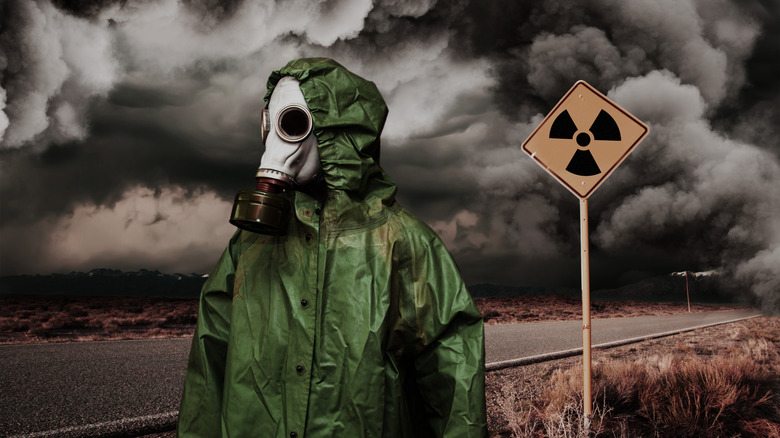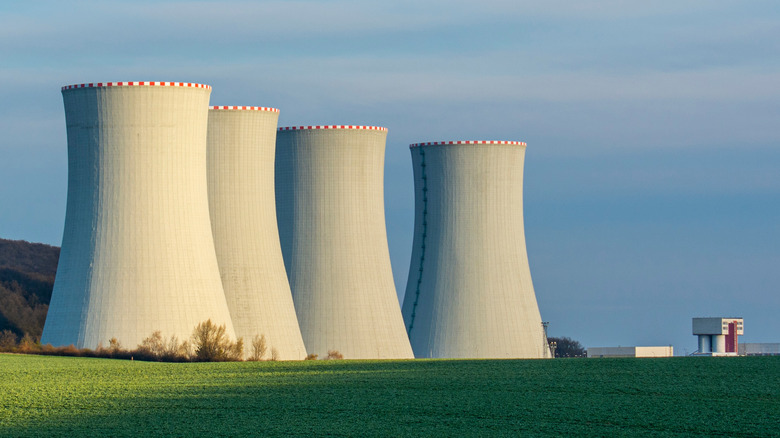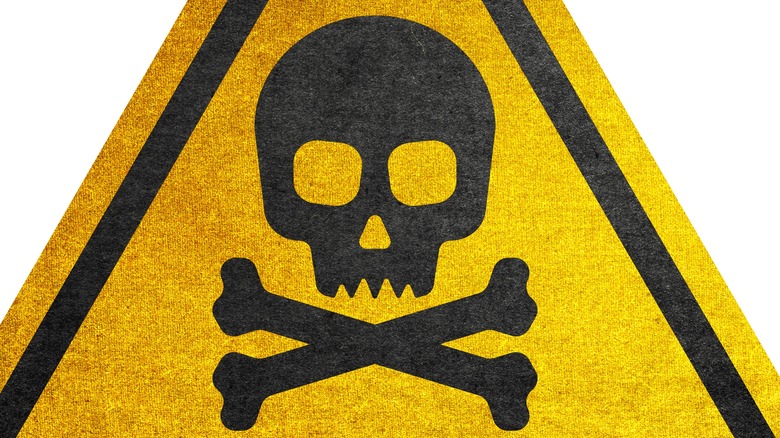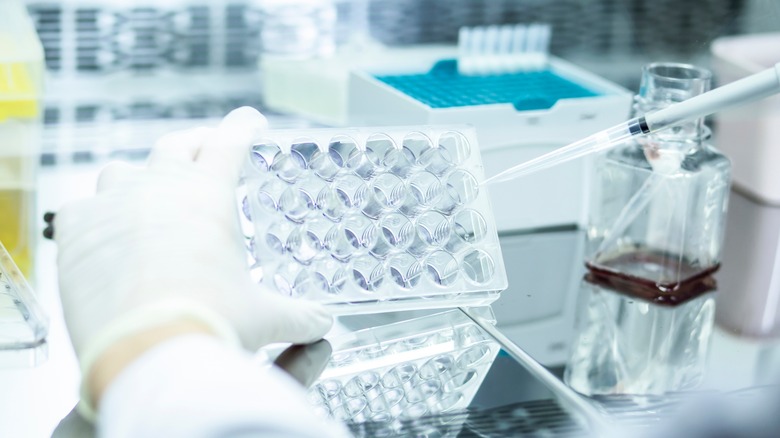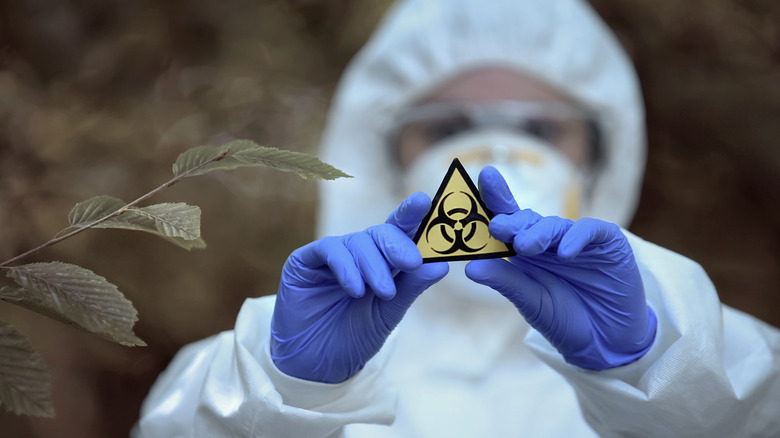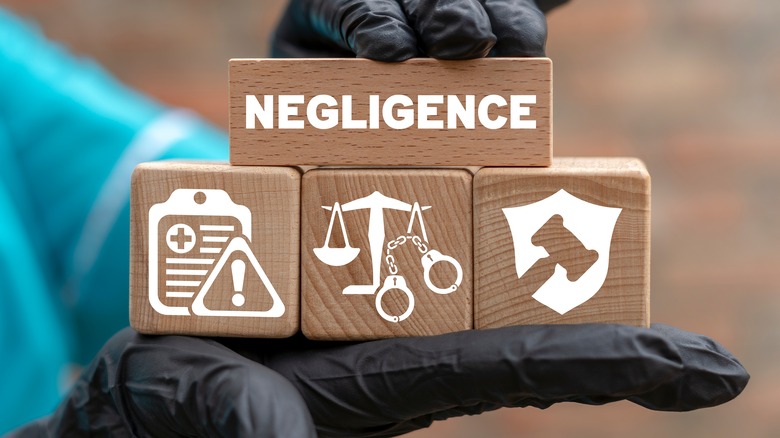The 83-Day Radiation Death Of Hisashi Ouchi
On September 30, 1999, a chain reaction at the Joyo fast research reactor in Tokaimura, Japan, triggered what is thought to be one of the country's worst nuclear accidents (via an article from the Bulletin of the Atomic Scientists). The BMJ reports that three workers, Hisashi Ouchi, Masato Shinohara, and Yutaka Yokokawa, were purifying uranium by hand when they should have been using a pump. Bad sales and stiff competition had pushed the company to take shortcuts. Adding insult to injury, HowStuffWorks writes that the employees were inexperienced. Simply put, it was a disaster waiting to happen. When the three placed too much uranium in a small tank, they were met with a blue flash.
The Washington Post states that Ouchi was holding a funnel near the tank when this occurred. Although he left the room, he vomited and collapsed. Then 35, Ouchi was married and had a son (via HowStuffWorks). Because he was closest to the reaction, he was irradiated with 17 sieverts, or 10 times the lethal dose (per IFLScience). He was also never trained on what to do if an accident occurred. According to the BMJ, Shinohara received 10 sieverts of radiation, while Yokokawa was exposed to three. The men were subsequently taken to the National Institute of Radiological Sciences in Chiba. As Ouchi and Shinohara had received extremely high doses of radiation, they were taken to the University of Tokyo Hospital. There, Ouchi would suffer immensely for months as radiation ravished his body (via All That's Interesting).
He looked fine at first
The BMJ explains that when Hisashi Ouchi and Masato Shinohara first arrived at the National Institute of Radiological Sciences, tests showed that their lymphatic blood count had plummeted to zero. IFLScience notes that this left their bodies exposed to infections. They were also nauseous, dehydrated, and had diarrhea. Even so, HowStuffWorks states that Ouchi looked okay from the outside. Although his face was red and swollen, he did not yet have any burns on his body. In other words, it didn't look like he had been exposed to a fatal dose of radiation.
The 2008 book "A Slow Death: 83 Days of Radiation Sickness" details that three days after the accident, Ouchi arrived at the University of Tokyo Hospital. At the time, he was still able to talk, although his right hand did appear to be swollen. Ouchi's condition, however, quickly took a turn for the worst. Per HowStuffWorks, doctors concluded that the radiation was breaking down his chromosomes. Additionally, Ouchi needed oxygen, his skin began to fall off, and he developed blisters. Soon after, Dr. Kazuhiko Maekawa from the Tokyo University Hospital said that Ouchi's chances of recovery were "very slim," per The Washington Post.
This is how radiation affects the body
The CDC explains that radiation gradually damages the body in a series of steps. For it to be as destructive as it was in Hisashi Ouchi's case, the dose of radiation must be large and distributed in a short amount of time. Ouchi, of course, received the brunt of the radiation during the accident in a matter of seconds (per HowStuffWorks). Furthermore, his symptoms were a classic example of severe radiation poisoning. His bone marrow cells were annihilated, which meant that his body was no longer creating red blood cells to carry oxygen or white blood cells to fight infections of any kind. In other words, Ouchi no longer had an immune system (via All That's Interesting).
HowStuffWorks states that Ouchi's suffering was immeasurable. His body could no longer regenerate skin, and he was unable to eat on his own. His eyes reportedly also bled. Per IFLScience, Ouchi was losing blood at an unprecedented rate and was having issues breathing. At one point, his heart stopped beating 59 days after the accident, but he was revived (per All That's Interesting). Doctors began to do skin grafts and blood transfusions in an effort to aid his recovery, to no avail. Then, they decided to try something new (per Science).
Doctors tried to save him using experimental techniques
According to All That's Interesting, doctors decided that Hisashi Ouchi would receive a stem cell transplant. Doctors chose this route instead of a bone marrow transplant with hopes that it would jumpstart his ability to produce blood. According to a Science article from October 1999, the stem cells came from his brother and were passed on to Ouchi via a transfusion. The publication notes that this treatment was also used on cancer patients. Ouchi's coworker, Masato Shinohara, also received the same treatment (however, he was unable to find a donor and received stem cells from a baby's umbilical cord).
The BMJ reports that doctors were not too optimistic about the stem cell transplant; they believed it was unlikely that either Ouchi or Shinohara would survive their ordeal. Per All That's Interesting, the treatment seemed to be successful. But soon, the radiation began to attack Ouchi's new cells. Furthermore, the skin grafts were unable to work as his DNA was far too damaged. Ouchi could no longer bear the pain and told doctors (per Yahoo News UK), "I can't take it anymore. I am not a guinea pig." By October of that year, Ouchi was in a coma (via the Bulletin of the Atomic Scientists).
The nuclear accident claimed two victims
Hisashi Ouchi died on December 21, 1999, 83 days after what is now known as the Tokaimura Criticality Accident (via HowStuffWorks). All That's Interesting reports that Ouchi had a total of three heart attacks while he received treatment for his injuries. Although he flatlined each time, his family insisted on keeping him alive. Ultimately, this caused damage to Ouchi's brain. IFLScience states that eventually, his kidneys, liver, and respiratory system shut down. His organ failure caused a heart attack, which led to his death. According to The Japan Times, the only reason Ouchi had lived so long was due to a large amount of blood and fluids that were given to him daily.
Meanwhile, Shinohara was still alive but in the hospital and in critical condition (via the Bulletin of the Atomic Scientists). However, The Guardian writes that in early 2000, his health had improved. So much so that he even took a stroll in the hospital's garden. Sadly, In February of that year, Shinohara developed respiratory issues. In April, Masato Shinohara, age 40, also died of organ failure. Per The Guardian, Yoshiro Mori, Japan's prime minister, said that his death was "extremely regrettable." Elsewhere, Dr. Kazuhiko Maekawa told the outlet, "I was overwhelmed by a sense of helplessness in the face of something caused by human arrogance." The publication notes that Yutaka Yokokawa survived and was released from the hospital in December 1999.
Human error caused the accident
According to the World Nuclear Association, the Tokaimura Criticality Accident resulted in 119 people being exposed to a high amount of radiation. The Bulletin of the Atomic Scientists writes that those that were exposed include nearby construction workers, as well as the paramedics that came to the aid of Ouchi, Shinohara, and Yokokawa. The chain reaction that the ill-fated employees had created lasted for 20 hours. The Washington Post reported that the accident led to over 75,000 people being checked for radiation exposure. The publication states that besides the possible physical damage, Tokaimura's reputation was also damaged as several local farmers noted that they were losing business because no one wanted to buy their crops.
In 2000, U.S. Nuclear Regulatory Commission announced that the officials behind the Joyo fast research reactor were at fault for the accident. They cited a lack of employee training and safety measures. Moreover, they explained that the accident could have been prevented. A 2003 article from The Sydney Morning Herald states that six officials from the company were eventually charged with negligence, including the plant's director, Kenzo Koshijima. Koshijima and the others were given a three-year suspended jail sentence. He was also ordered to pay a fine. The Joyo fast research reactor's license was revoked in 2000, although All That's Interesting notes that another company took it over until it finally closed its doors in 2011.
